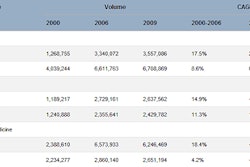Physician self-referral for advanced imaging exams is leading to increased healthcare spending, with little evidence that patients are enjoying any perceived benefits from the practice, such as convenience from same-day exams, according to a series of articles published this week in Health Affairs.
The series included studies conducted by researchers from the American College of Radiology (ACR) of Reston, VA, and Stanford University of Stanford, CA, that found that the most-touted benefits of self-referral -- convenient, same-day imaging for patients and shorter illness durations -- are actually rarely realized (Health Affairs, December 2010, Vol. 29:12, pp. 2231-2259).
The problem of physician self-referral in imaging has mostly been discussed within the radiology arena. The articles in the December issue of Health Affairs broaden the debate beyond the specialty, according to Donald Metz, executive editor.
"What stands out to us [about physician self-referral] is that the way healthcare is organized can have effects on cost and quality. The whole question of self-referral is a big one in policy and research circles for just these reasons," Metz said. "We had been receiving a number of articles on the issue, which reflects this interest, and saw that we could form a natural cluster on the topic."
Policymakers continue to search for the right mechanisms for containing self-referral, and for ensuring that Medicare beneficiaries receive only medically necessary imaging studies, regardless of who owns or operates the equipment, wrote Bruce Hillman, MD, of the University of Virginia in Charlottesville, in an overview.
"Physician self-referral is more than just an imaging issue," he told AuntMinnie.com. "It's about whether doctors are dealing fairly with patients and putting their interest ahead of their own."
One-stop service? That depends
The idea that physician self-referral offers patients a convenience benefit has long been cited by its proponents, according to Jonathan Sunshine, senior director for research at the ACR. In a study conducted with colleague Mythreyi Bhargavan, Sunshine analyzed 2006 and 2007 Medicare data that showed that self-referral resulted in same-day imaging for only 15% of advanced procedures such as CT or MRI.
"One of the principle advantages claimed for self-referral is that it provides one-stop service: The patient doesn't have to go somewhere else for imaging but gets it at the same time and at the same place as the doctor visit," Sunshine told AuntMinnie.com. "If this actually happened, it would have advantages, such as convenience and getting started on treatment sooner. But it happens infrequently for advanced imaging."
Physician self-referred general x-ray exams do tend to happen on the same day as an office visit, though, Sunshine said: almost 75% of the time.
"This finding allows policymakers to target what's really necessary [to address the imaging self-referral issue]," he said. "Rather than reining in all imaging, focusing on advanced imaging would make more sense."
Self-referral doesn't reduce length of illness
In another study, Danny Hughes, assistant director for research at ACR, along with colleagues found that self-referral increased healthcare costs but did not decrease a patient's length of illness -- with the exception of when doctors self-referred patients for x-rays for common conditions such as sinusitis, chest pain, or respiratory illness.
Hughes' team found that the mean total episode cost was in the range of 4% to 10% higher with self-referral than without, depending on the type of imaging studied (echocardiography for the diagnosis of heart disease was the highest). Mean imaging cost per episode was 27% to 40% higher with self-referral, with the largest cost excess for episodes of heart disease in which the treating physician self-referred ultrasound scans, according to Hughes.
"We expected to find that the cost of healthcare would increase with increased utilization," he told AuntMinnie.com. "But whether the duration of a patient's illness would improve was anyone's guess. We found that same-day imaging doesn't occur as much as it's supposed to, and the illness durations aren't shorter."
Supporters of physician self-referral have said that the benefits of the practice offset its additional cost. But that's just not true, Hughes said.
"If we're worrying about runaway healthcare cost, [physician self-referral] is clearly a place where something could be done," he said. "Our results find that there's no offset once you've addressed the issue of same-day imaging."
The Stark law, which bans self-referral outside of physician offices, and measures such as the Deficit Reduction Act (DRA) of 2005 haven't been sufficiently effective, according to Hughes. And if studies show that self-referred imaging is still increasing while the aggregate growth of imaging has leveled off since the mid-2000s, that's a red flag, he said.
"[The U.S. Centers for Medicare and Medicaid Services (CMS)] has tried to control overutilization via pricing mechanisms, but that strategy punishes all imagers, whether they're performing imaging correctly or not," he said. "And the DRA is similar, cutting across the board. It's ironic that if there's anyone who can make up volume, it's the physician who owns his or her own equipment, rather than the radiologist who relies on referrals."
Buy an MRI, drive up spending
Another study in the Health Affairs issue examined how the acquisition of MRI equipment by nonradiologists drives up imaging use and spending. Laurence Baker, MD, chief of health services research at Stanford University, found that these physicians ordered substantially more scans once they began billing for MRI.
"It's not surprising that when physicians acquire imaging equipment they tend to use it more, but how important the effect of this trend is has not been clear," Baker told AuntMinnie.com.
Baker analyzed changes in imaging use and in overall spending by patients of orthopedists and neurologists who began billing for MRI scans between 1999 and 2005. After orthopedists began billing for MRI, the number of MRI procedures used within 30 days of a patient's first visit increased by 38%, from an average of 74 procedures per 1,000 visits before acquiring MRI to 103 afterward. As for neurologists, the average 30-day MRI rate grew by about 20%, from 241 per 1,000 episodes before doctors acquired MRI equipment to 287 after acquisition.
Baker found that not only did costs grow from more MRI exams, they also grew from additional follow-up procedures.
"Doctors that do more MRIs spend more on MRI, but they also spend more money on other follow-up tests and procedures," he said. "The study showed increases in overall spending not just from imaging procedures but from other things doctors are doing."
What's the real bottom line?
The bottom line isn't money, but whether patients are benefiting from physician self-referred imaging, according to Baker.
"Are patients getting better? Are outcomes better? If there isn't good evidence that patients are healthier, and if there is good evidence that we're spending more, we need to investigate," he said.
By Kate Madden Yee
AuntMinnie.com staff writer
December 8, 2010
Related Reading
Self-referral by nonradiologists continues to drive imaging use rates, November 17, 2010
Self-employed urologists order more imaging, November 9, 2010
GAO numbers overstate growth in medical imaging, May 4, 2010
GAO takes on self-referral study, April 29, 2010
Medicare cancer imaging grows at twice rate of overall expenses, April 27, 2010
Copyright © 2010 AuntMinnie.com



















